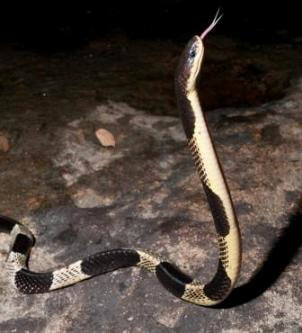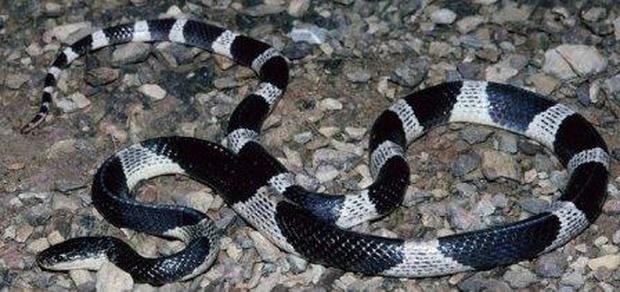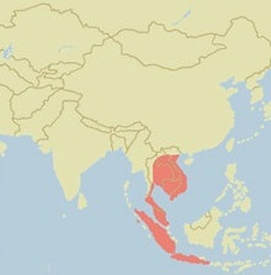Blue Krait (Malayan Krait)Bungarus candidus |

Custom Search
|
|
The Blue Krait is also known as the Malayan Krait (Bungarus candidus) is a highly venomous elapid snake species native to Southeast Asia.
These snakes are found in Peninsular Malaysia, central Viet Nam, Thailand, Bali, Lao People's Democratic Republic, Indonesia, Singapore, and Sumatra. The blue Krait is probably the most venomous snake found in Asia and it ranks among the deadliest snakes in the world! This type of snakes lives in a wide variety of habitats from lowlands up to 1200 m high, very often close to a water source. Amongst their preferred habitats are rocky areas and waterways but it also inhabits deciduous shrubby areas with sandy soils, hill forests, primary evergreen forests or plantations. Blue kraits are also found close to rice fields and rice dams, it can even be found in villages and cities. This is a very secretive and nocturnal species, usually hiding during the day. The Common or Indian Krait (Bungarus caeruleus) is also known by the common name of Blue Krait and although they belong to the same genus, Bungarus, these are two completely different species.
These kraits average length is about 43 inches (108 cm) but the maximum length may reach up to 63 inches (160 cm). There are some differences between populations found in different parts of its range, but the Blue Krait almost always displays a banded pattern.
The black dark-brown, or bluish-black cross bands alternate with yellowish-white which may have some black specks. Sometimes unbanded all black individual may occur though it is very rare. Their belly is uniformly white and the head has a dark color and their dorsal scales are smooth. They aren't considered very aggressive or defensive, the blue krait doesn’t tend to bite unless it is really provoked at least during the daytime. These shy snake will most often attempt to cover their head with their tail. The blue krait is so "docile" during the daytime that many snake handlers very often will handle these deadly snakes with their bare hands. Subspecies / Etymology /Taxonomy
There aren't any subspecies recognized by scientists for the Blue Krait. Venom / Bite The blue krait venom contains powerful neurotoxins that attack the human nervous system, forcing it to shut down. After envenomation death may occur within 12 to 24 hours, if left untreated the mortality rate is about 60 to 70% in humans. But even with antivenom treatment, 50% of the bites from the Blue Krait prove to be fatal. Bite victims usually die from respiration failure, due to the paralysis of crucial muscles and nerves necessary for this function like the diaphragm. When they bite very little or even no pain is usually felt at the bite location. This makes them extremely dangerous to people living in remote and small villages which usually lay down on the floor to sleep and may get bitten while sleeping. The blue krait venom IV LD50 value in mice is 0.1 mg/kg, making it more toxic than that of monocled cobra (Naja kaouthia) and 15 times more toxic than that of the Common Cobra. In Vietnam American soldiers used to call them the "five-step snake", meaning that if you got bitten by a krait you would take five steps and then die. If Blue Krait antivenin isn't available, the Australian Tiger Snake (Notechis scutatus) antivenin can be used as a substitute. Diet / Feeding Blue kraits are an ophiophagus species, meaning that they feed on other snakes even those of their own kind. But they will also eat amphibians, lizards, occasionally they feed on small mammals like mice and other small animals. Unlike other venomous snakes that are ambush predators, they are active hunters, moving around at night in search of prey. Reproduction Not much is known about the blue krait reproduction behaviors, other than it's oviparous, meaning these snakes lay eggs. Usually, they will invade and take over rat holes in the ground to make their nest. Some observations do state that the males engage in ritual fighting. In Thailand, females lay their eggs in March and April, and after the incubation period, the eggs hatch in June or July. The average clutch comprises 4 to 10 eggs, at birth the young are about 30 cm long with a coloration similar to that of adults. Conservation / Threats The Blue Krait is listed as a "Least Concern" species due to its wide distribution. These deadly snakes are harvested for traditional medicine, food and for their skin in parts of their range. However isn't clear how this is impacting the species population and only further research may shed some light on the impact of their exploitation. Even though most likely there's no major threat to them, like all snakes they most likely suffer from human persecution.
|
Scientific classification |
© 2014 Snake Facts About Us | Privacy Policy | Contact





